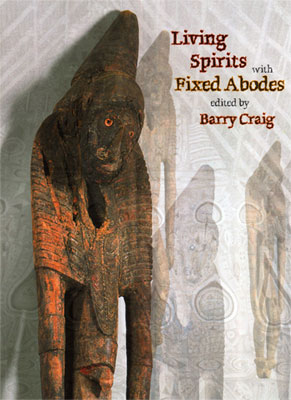Living Spirits with Fixed Abodes
Synopsis:
On the eve of Papua New Guineas attainment of Independence from Australia, Chief Minister Michael Somare referred to the new nation’s cultural treasures as living spirits with fixed abodes. He was referring to the prevailing belief of Papua New Guineans that everything is invested with spirit, not least the objects carved, modelled or constructed for ceremonial, and often everyday use.
In 1977, the Papua New Guinea National Museum and Art Gallery moved into a new building, located next to, but constructed before, the National Parliament. The new nation adopted a constitution, the preamble to which asserts:
We, the people of Papua New Guinea … pay homage to the memory of our ancestors
… [and] acknowledge the worthy customs and traditional wisdoms of our people …
Thus the cultural heritage of the nation was given a very high priority.
Exhibitions at the new museum building were developed to show the prehistory of the people, some of the more striking natural heritage, and a selection of the most significant cultural treasures were given pride of place in the central exhibition hall.
Contents:
The Masterpieces Exhibition remains in place today and this book gives the reader a thorough account of each of the 209 objects on display. The Introduction by the Editor, a former Curator of the National Museum, aims to give the non-Papua New Guinean reader a general idea of the signifi cance of these objects and how they are to be understood. Two chapters by Dr Mark Busse, also a former Curator, provide a brief history of the Museum and outline its functions. A chapter on the role of the Museum in forging national identity is provided by Soroi Marepo Eoe, a former Curator and Director of the National Museum to the present time.
The Editor has written the chapter on the Masterpieces, setting these important works in their local context with historical and fi eld photographs. The objects are dealt with under the headings: Watercraft, Architecture, Household items, Gardening and fertility fi gures, Hunting and warfare, Musical instruments, Masks and mortuary objects. An appendix provides a window into the history and representativeness of the National Museum’s entire collection of well over 35,000 pieces. Indices give the reader tools with which to explore a range of topics such as where the exhibition objects have come from, who collected, gave or sold them to the museum, and who were responsible for the contextual photographs. A series of maps locates every place mentioned in the text. It is evident that such an exhibition, and the book arising from it, is a result of the individual and collective efforts of a very large number of people.
Thirty years after the birth of the nation, this book reaffirms the central significance of the traditional works created to house the spirits.
Editor:
Dr Barry Craig obtained his BA (Hons. Anthropology), Dip.Ed. and MA (Hons. Anthropology) at the University of Sydney. His interest is in material culture and art of New Guinea, and was inspired by the late Bryan Cranstone of the British Museum. His masters thesis, ‘Houseboards and Warshields of the Mountain Ok’ was published in summary form in 1988. In 1980-83 he was Curator of Anthropology at the Papua New Guinea National Museum, and was appointed Curator of Foreign Ethnology at the South Australian Museum in 1995. In 1997 he was awarded a PhD in Visual Arts at Flinders University for his thesis on the collection, documentation and preservation of the material cultural heritage of Papua New Guinea.
|
|

AUTHOR:
Editor: Barry Craig
STATUS:
New Release
PRICE:
$89.95
ILLUSTRATIONS:
Over 320 full colour illustrations, maps
FORMAT:
Hard cover, jacket, 296pp
DIMENSIONS:
297 x 214mm
ISBN:
1863332588
|
|

